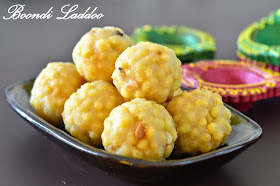Here is my next sweet for this
Diwali. This is really a very easy and simple sweet and get ready very quickly.
There was a time a my mother used to prepare this sweet every year for Diwali.
This was also one of the first sweets I learnt to prepare. I like to prepare it with the Vanilla essence
but you can add even pineapple essence. I have not tried any other flavours. You
can add any food color of your choice. I prefer not to add food color. So do
try this really easy yet delicious burfi this Diwali.
Yeild – 14 to 15 medium sized pieces
What you'll need
- Maida/All Purpose Flour – ¾ cup
- Sugar – 1 cup
- Ghee, melted – ¼ cup
- Vanilla Essence – few drops
Method
- Grease a tray with ghee and set aside.
- In a Kadai, add the ghee, once ghee is hot, and maida and fry the maida on medium heat for 4 to 5 minutes or until the raw smell of the flour disappears. Take care not to burn the maida. Keep aside.
- Heat a non stick kadai, add the sugar with ¼ cup water and dissolve the sugar. Heat the sugar syrup until the syrup reaches one string consistency. To test consistency, take a drop of the syrup in between your thumb and index finger and gently bring the fingers apart, you should see a single thread of sugar syrup.
- Now, switch off the flame/heat add the essence to the syrup.
- Add the fried maida and keep stirring. Keep stirring continuously till the whole mixture comes together as a mass/ball, took me about 5 minutes.
- Transfer to a greased plate and flatten the top with a butter paper of with the greased bottom of a flat cup like davara.
- Let cool for couple of minutes and then mark the pieces with a sharp knife.
- Cool and remove pieces and store in airtight container.
Notes:
- I added Vanila essence and did not add any color. But you can add any food color of your choice, like yellow color and also change the essence to pineapple or a flavour of your choice. But my personal favourite is Vanilla.
- Mix continuously till the mixture leaves the sides of the kadai and comes together as a mass/ball.









